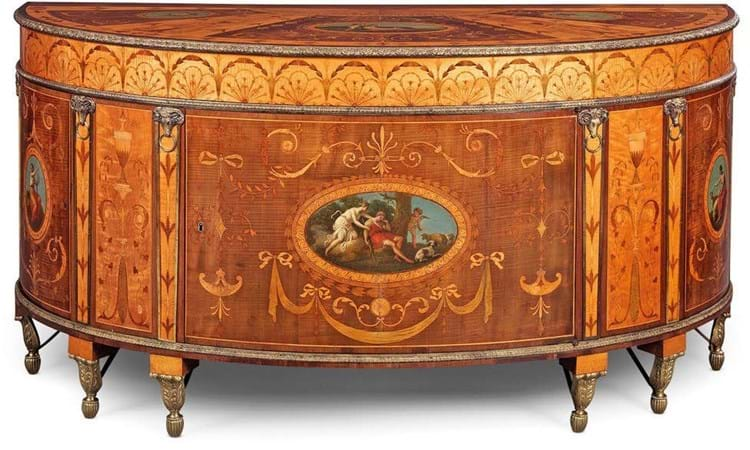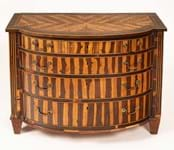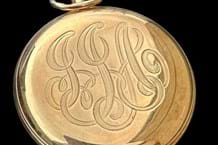
George III commode attributed to Ince and Mayhew sold for £270,000 at Christie’s on July 6.
Image: Christie’s Images Limited 2023
Traditionally some of the finest examples of cabinetmaking, both English and Continental, are offered by the main London rooms at the end of the summer season in July.
Time was when this meant dedicated furniture auctions but these days such pieces will more often be incorporated into mixed-discipline auctions featuring furniture, works of art and sometimes top pieces of silver and ceramics and horology.
The prime illustrations of this trend are Sotheby’s and Christie’s Treasures and Exceptional sales where you can find examples of all the above.
English neoclassicism
While many of the pieces of furniture included in Christie’s (26/21/15% buyer’s premium) Exceptional sale on July 6 were of Continental manufacture, the sale also included this example of English neoclassicism pictured here.
The George III, 6ft (1.84m) wide, semi elliptical satinwood, harewood and marquetry commode, which is fitted with a range of different sized drawers and cupboards, is attributed to the then fashionable partnership of Ince and Mayhew.
The firm specialised in highly decorative marquetry and painted panels featuring classical elements inspired by the neoclassical architectural style of Robert Adam.
As well as the elements of delicate classical marquetry such as anthemia and swags, the commode features painted panels depicting classical subjects: Cupid garlanding Venus in a landscape with putti and Diana surprising the sleeping Endymion, as well as ormolu mounts to the feet, borders and the capitals of the pilasters that divide the front.
The commode is part of a group of bow-fronted or serpentine form attributed to Ince and Mayhew that was identified by Hugh Roberts in his 1985 article in the Burlington Magazine titled The Derby house Commode.
In November 1775 the partnership supplied an ormolu mounted satinwood, harewood and marquetry commode that had been designed by Robert Adam for the Countess of Derby’s dressing room at Derby House in London.
Auction veteran
The example offered in the Exceptional sale has a lengthy provenance that includes several previous appearances under the hammer at Christie’s.
Until 1947 it had passed down in the Mildmay family.
It was possibly made to celebrate the marriage of Sir Henry Paulet St John to Jane, heiress of the Mildmay family for Dogmersfield Park, Hampshire.
Alternatively it entered the family through the marriage of Sir Henry’s son, Humphrey St John Mildmay to Anne Baring who was the eldest daughter of the collector and connoisseur of English furniture, Alexander Baring, 1st Lord Ashburton (1774-1848).
In 1947 it made the first appearance at Christie’s and its next owner was the Hon Daisy Fellowes, the editor of Harper’s Bazaar and featured in her Berkshire home, Donnington Grove.
It was sold at Christie’s in 1984 by her descendants and the commode then entered the collection of Barbara Piasecka Johnson, making a third appearance at the auction house in July 1992 when it was sold from her collection for a substantial £600,000.
Acquired by the 10th Earl of Portsmouth, it then passed down by descent at Farleigh House in Hampshire.
Offered this time in the Exceptional sale with a guide of £300,000-500,000, it sold for £270,000.














